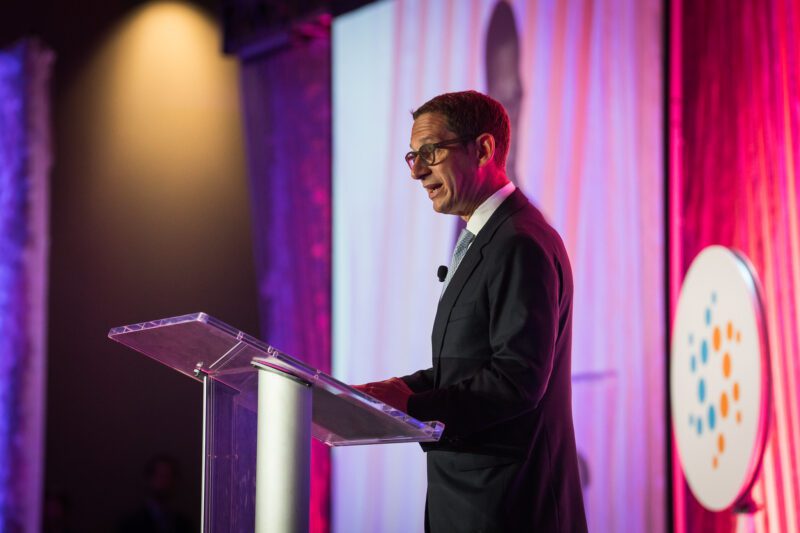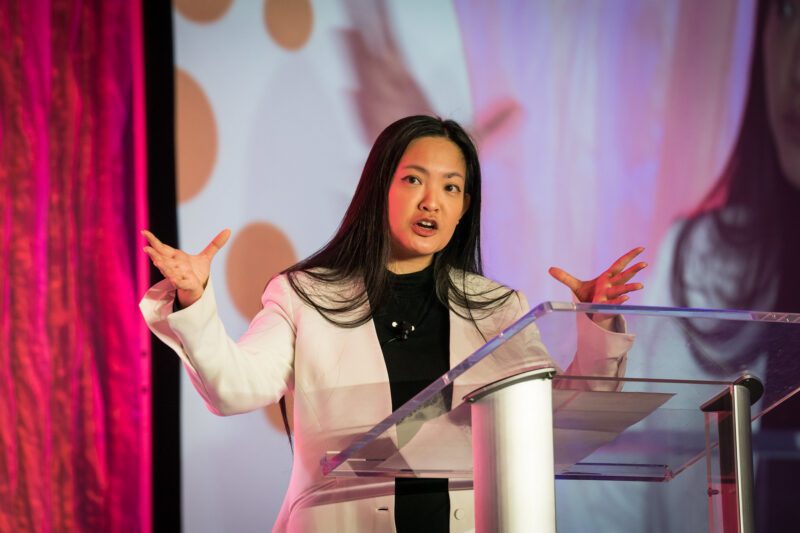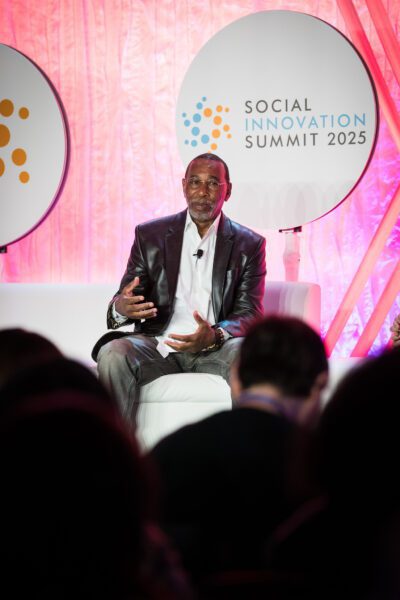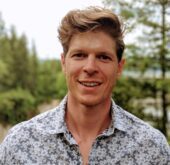Navigating the New San Francisco
Reflections from the 2025 Social Innovation Summit
Reflections from the 2025 Social Innovation Summit

San Francisco Mayor Daniel Lurie at the 2025 Social Innovation Summit
Waves of applause greeted Mayor Daniel Lurie as he strode onstage at the Hyatt Regency Ballroom to open Day Two of the Social Innovation Summit in San Francisco. “For the first time in years,” the mayor declared to the full house, “there is a sense of hope and optimism in our city.”
Lurie’s presence carried gravitas beyond the trappings of office. A former nonprofit leader and longtime civic entrepreneur, he built his reputation not just on policy but on practice. Twenty years ago, he founded Tipping Point Community to tackle structural poverty in the Bay Area. In 2024 alone, the organization deployed over $31 million in catalytic capital to its portfolio of partners, which then leveraged those funds to unlock more than $280 million in co-financing for anti-poverty and workforce initiatives — reaching over 90,000 low-income residents.

San Francisco Mayor Daniel Lurie
But Lurie wasn’t there to reflect on the past. He offered data that signaled economic momentum: “Convention bookings at Moscone Center are up 53% year over year, hotel room nights are up 50%.” These rebounds translate into thousands of restored jobs and reactivated small businesses. Yet the true economic story, Lurie argued, lies in how institutions are reinvesting in the city’s future. “Companies like Databricks and JPMorgan are doubling down on San Francisco, investing billions. They’re growing their office footprints and keeping their flagship conferences right here.”
Crucially, these aren’t just real estate decisions. JPMorgan’s expanded presence is linked to ESG-informed lending practices, while Databricks is collaborating with community colleges and accelerators to cultivate a more inclusive AI talent pipeline. In this way, San Francisco is becoming a case study in place-based regeneration — pairing global capital with local ecosystems in service of inclusive prosperity.
The summit’s theme, “Navigating the New Era,” could not have felt more apt. While the economic indicators suggest recovery, the deeper shift was palpable in the conversations: animated, urgent, and charged with the sense that this city, long mythologized for its peaks and crashes, is in the midst of an identity reinvention. Attendees weren’t merely exploring solutions; they were prototyping what a resilient, post-crisis urban economy might actually look like.
The summit didn’t just showcase individual innovations; it revealed the contours of a new civic and economic architecture.
That spirit of reinvention found a powerful embodiment in Amanda Nguyen. In 2013, during her final year at Harvard, Nguyen was raped and encountered a legal system riddled with procedural injustice. Massachusetts law at the time allowed rape kits to be destroyed after six months unless survivors filed extensions, a process that forced them to relive their trauma repeatedly, despite a 15-year statute of limitations.

Amanda Nguyen at the 2025 Social Innovation Summit
Rather than accept the system’s shortcomings, Nguyen turned her lived experience into legislative action. She drafted the Sexual Assault Survivors’ Bill of Rights, which Congress passed unanimously in 2016. The law established national standards for evidence retention and access. Today, her organization Rise is scaling that advocacy globally through an entrepreneurial model of policy transformation rooted in the belief that “the best people to solve problems are those who live them every day.” This philosophy mirrors a central premise of the impact economy: that system change often originates at the margins, not the center.

Jump author Larry Miller at the 2025 Social Innovation Summit
Larry Miller’s keynote carried a parallel theme — but from the private sector. A former teenage gang member convicted of murder, Miller defied expectation to become the president of Nike’s Jordan Brand and later the Portland Trail Blazers. For decades, he hid his past, until his daughter encouraged him to share his full story in their co-authored memoir Jump. Today, Miller leads the Justice and Upward Mobility Project (JUMP), a workforce development initiative that bridges economic opportunity for those impacted by the justice system.
JUMP exemplifies a growing wave of “justice-integrated entrepreneurship” — ventures and initiatives that align employment pipelines with economic redress. In San Francisco, such programs are gaining momentum, transforming formerly incarcerated or unhoused individuals into skilled workers in sectors like renewable energy, culinary arts, and infrastructure maintenance. These models reflect an evolving ethos: that sustainable economic development must include, not exclude, those historically marginalized by the system.
Throughout the summit’s breakout sessions, this ethos translated into design. Tech entrepreneurs and urban planners explored how AI could enhance, not erode, human connection. Impact investors debated risk-sharing instruments for workforce reskilling and gig economy protections. Philanthropic leaders discussed the shift from traditional grantmaking toward regenerative finance strategies where catalytic capital and blended vehicles can de-risk investment in high-impact enterprises while aligning with measurable SDG outcomes.
In effect, the summit didn’t just showcase individual innovations; it revealed the contours of a new civic and economic architecture. One based not on extraction and scalability for its own sake, but on interdependence, trust, and resilience.
Mayor Lurie has echoed this pragmatism in City Hall. “We’re staying laser focused on the basics — safe and clean streets, a growing economy, and a city government that works for everyone,” he told the audience. That includes streamlining permitting processes for small businesses and startups, expanding support for impact entrepreneurs, and forging new public-private investment platforms to address housing, infrastructure, and climate adaptation.
As the summit concluded, Lurie’s parting words landed with quiet force: “Under my leadership, San Francisco won’t just imagine the future. We will build it.”
In a city where innovation is cultural liturgy, that promise feels less like a campaign line and more like an invocation. Walking out through the Embarcadero, past R-Evolution’s towering sculpture and the clinking of wine glasses in the Ferry Building, one felt not the ghost of a tech boom past but the scaffolding of something more grounded, more regenerative, rising into view.
San Francisco’s next act won’t be a return. It will be a reimagining — forged in crisis, built through collaboration, and powered by the belief that impact and enterprise can, and must, align.
Related Content
Comments
Deep Dives

Featuring
Clarisse Awamengwi
IE Correspondent
July 17 - 12:00 PM EST

Featuring
Russell McLeod
July 24 - 12:00 PM EST
RECENT
Editor's Picks
Webinars
News & Events
Subscribe to our newsletter to receive updates about new Magazine content and upcoming webinars, deep dives, and events.
Become a Premium Member to access the full library of webinars and deep dives, exclusive membership portal, member directory, message board, and curated live chats.
At Impact Entrepreneur, we champion fearless, independent journalism and education, spotlighting the inspiring changemakers building the Impact Economy. Diversity, equity, sustainability, and democracy face unprecedented threats from misinformation, powerful interests, and systemic inequities.
We believe a sustainable and equitable future is possible—but we can't achieve it without your help. Our independent voice depends entirely on support from changemakers like you.
Please step up today. Your donation—no matter the size—ensures we continue delivering impactful journalism and education that push boundaries and hold power accountable.
Join us in protecting what truly matters. It only takes a minute to make a real difference.
0 Comments